Experimental Demonstration of a Visible Light Communications System Based on Binary Frequency-Shift Keying Modulation: A New Step toward Improved Noise Resilience
Abstract
1. Introduction
- ✓
- i. Analyzing the opportunity of using BFSK modulation in VLC applications;
- ✓
- ii. Developing and implementing a BFSK VLC prototype;
- ✓
- iii. Experimentally evaluating the BFSK VLC prototype while comparing its performances with the ones of a classical VLC solution based on OOK modulation;
- ✓
- iv. Demonstrating experimentally the fact that BFSK provides enhanced noise resilience in VLC applications.
2. State of the Art in Noise-Resilient Visible Light Communications Systems
3. Binary Frequency-Shift Keying Visible Light Communications Concept Presentation
4. Design and Implementation of the Visible Light Communications System with BFSK
4.1. VLC BFSK Emitter
4.2. VLC BFSK Receiver
5. Experimental Results
5.1. Experimental Procedure and Methods
5.1.1. The Initial Calibration for the Experiment
5.1.2. The Resilience to Optical Noise Test
5.2. Experimental Results in Ambient Optical Noise
5.3. Debate on the Experimental Results
6. Conclusions and Discussions
Author Contributions
Funding
Institutional Review Board Statement
Informed Consent Statement
Data Availability Statement
Conflicts of Interest
References
- Rehman, S.U.; Ullah, S.; Chong, P.H.J.; Yongchareon, S.; Komosny, D. Visible Light Communication: A System Perspective—Overview and Challenges. Sensors 2019, 19, 1153. [Google Scholar] [CrossRef] [PubMed]
- Matheus, L.E.M.; Vieira, A.B.; Vieira, L.F.M.; Vieira, M.A.M.; Gnawali, O. Visible Light Communication: Concepts, Applications and Challenges. IEEE Commun. Surv. Tutor. 2019, 21, 3204–3237. [Google Scholar] [CrossRef]
- Do, T.-H.; Yoo, M. An in-Depth Survey of Visible Light Communication Based Positioning Systems. Sensors 2016, 16, 678. [Google Scholar] [CrossRef] [PubMed]
- Zhuang, Y.; Hua, L.; Qi, L.; Yang, J.; Cao, P.; Cao, Y.; Wu, Y.; Thompson, J.; Haas, H. A Survey of Positioning Systems Using Visible LED Lights. IEEE Commun. Surv. Tutor. 2018, 20, 1963–1988. [Google Scholar] [CrossRef]
- Liang, Q.; Sun, Y.; Liu, C.; Liu, M.; Wang, L. LedMapper: Toward Efficient and Accurate LED Mapping for Visible Light Positioning at Scale. IEEE Trans. Instrum. Meas. 2022, 71, 8500612. [Google Scholar] [CrossRef]
- The Commission Calls for a Climate Neutral Europe by 2050; European Union Press: Brussels, Belgium, 2018.
- Imam-Fulani, Y.O.; Faruk, N.; Sowande, O.A.; Abdulkarim, A.; Alozie, E.; Usman, A.D.; Adewole, K.S.; Oloyede, A.A.; Chiroma, H.; Garba, S.; et al. 5G Frequency Standardization, Technologies, Channel Models, and Network Deployment: Advances, Challenges, and Future Directions. Sustainability 2023, 15, 5173. [Google Scholar] [CrossRef]
- Varotsos, G.K.; Aidinis, K.; Katsis, A.; Nistazakis, H.E. Capacity Performance Analysis for Terrestrial THz Channels. Electronics 2023, 12, 1336. [Google Scholar] [CrossRef]
- Căilean, A.M.; Dimian, M. Current Challenges for Visible Light Communications Usage in Vehicle Applications: A Survey. IEEE Commun. Surv. Tutor. 2017, 19, 2681–2703. [Google Scholar] [CrossRef]
- Memedi, A.; Dressler., F. Vehicular Visible Light Communications: A Survey. IEEE Commun. Surv. Tutor. 2021, 23, 161–181. [Google Scholar] [CrossRef]
- Bian, R.; Tavakkolnia, I.; Haas, H. 15.73 Gb/s Visible Light Communication With Off-the-Shelf LEDs. J. Light. Technol. 2019, 37, 2418–2424. [Google Scholar] [CrossRef]
- Stoyanova, M.; Nikoloudakis, Y.; Panagiotakis, S.; Pallis, E.; Markakis, E.K. A Survey on the Internet of Things (IoT) Forensics: Challenges, Approaches, and Open Issues. IEEE Commun. Surv. Tutor. 2020, 22, 1191–1221. [Google Scholar] [CrossRef]
- Sejan, M.A.S.; Chung, W.-Y. Secure VLC for Wide-Area Indoor IoT Connectivity. IEEE Internet Things J. 2023, 10, 180–193. [Google Scholar] [CrossRef]
- Xu, Y.; Hu, X.; Sun, Y.; Yang, Y.; Zhang, L.; Deng, X.; Chen, L. High-Accuracy Height-Independent 3D VLP Based on Received Signal Strength Ratio. Sensors 2022, 22, 7165. [Google Scholar] [CrossRef] [PubMed]
- Merah, M.M.; Guan, H.; Chassagne, L. Experimental Multi-User Visible Light Communication Attocell Using Multiband Carrierless Amplitude and Phase Modulation. IEEE Access 2019, 7, 12742–12754. [Google Scholar] [CrossRef]
- Căilean, A.-M.; Beguni, C.; Avătămăniţei, S.-A.; Dimian, M. Experimental Demonstration of a 185 Meters Vehicular Visible Light Communications Link. In Proceedings of the 2021 IEEE Photonics Conference (IPC), Vancouver, BC, Canada, 18–21 October 2021; pp. 1–2. [Google Scholar] [CrossRef]
- Căilean, A.-M.; Avătămăniţei, S.-A.; Beguni, C.; Popa, V.; Dimian, M. Experimental Demonstration of a 188 Meters Infrastructure-to-Vehicle Visible Light Communications Link in Outdoor Conditions. In Proceedings of the 2021 IEEE Sensors Applications Symposium (SAS), Sundsvall, Sweden, 23–25 August 2021; pp. 1–6. [Google Scholar] [CrossRef]
- Avătămăniței, S.A.; Căilean, A.-M.; Done, A.; Dimian, M.; Prelipceanu, M. Noise Resilient Outdoor Traffic Light Visible Light Communications System Based on Logarithmic Transimpedance Circuit: Experimental Demonstration of a 50 m Reliable Link in Direct Sun Exposure. Sensors 2020, 20, 909. [Google Scholar] [CrossRef] [PubMed]
- Avătămăniței, S.-A.; Căilean, A.-M.; Done, A.; Dimian, M.; Popa, V.; Prelipceanu, M. Design and Intensive Experimental Evaluation of an Enhanced Visible Light Communication System for Automotive Applications. Sensors 2020, 20, 3190. [Google Scholar] [CrossRef]
- Umair, M.A.; Meucci, M.; Catani, J. Strong Noise Rejection in VLC Links under Realistic Conditions through a Real-Time SDR Front-End. Sensors 2023, 23, 1594. [Google Scholar] [CrossRef]
- Nawaz, T.; Seminara, M.; Caputo, S.; Mucchi, L.; Cataliotti, F.S.; Catani, J. IEEE 802.15.7-Compliant Ultra-Low Latency Relaying VLC System for Safety-Critical ITS. IEEE Trans. Veh. Technol. 2019, 68, 12040–12051. [Google Scholar] [CrossRef]
- Shen, W.; Tsai, H. Testing Vehicle-to-Vehicle Visible Light Communications in Real-World Driving Scenarios. In Proceedings of the 2017 IEEE Vehicular Networking Conference (VNC), Torino, Italy, 27–29 November 2017; pp. 187–194. [Google Scholar]
- Avătămăniței, S.-A.; Beguni, C.; Căilean, A.-M.; Dimian, M.; Popa, V. Evaluation of Misalignment Effect in Vehicle-to-Vehicle Visible Light Communications: Experimental Demonstration of a 75 Meters Link. Sensors 2021, 21, 3577. [Google Scholar] [CrossRef]
- Căilean, A.-M.; Beguni, C.; Avătămăniței, S.-A.; Dimian, M.; Popa, V. Design, Implementation and Experimental Investigation of a Pedestrian Street Crossing Assistance System Based on Visible Light Communications. Sensors 2022, 22, 5481. [Google Scholar] [CrossRef]
- Plascencia, E.; Guan, H.; Chassagne, L.; Barrois, O.; Shagdar, O.; Căilean, A.-M. A Comprehensive Investigation on Multi-User Interference Effects in Vehicular Visible Light Communications. Sensors 2023, 23, 2553. [Google Scholar] [CrossRef] [PubMed]
- Plascencia, E.; Guan, H.; Chassagne, L.; Căilean, A.-M.; Barrois, O.; Shagdar, O. Addressing Multi-User Interference in Vehicular Visible Light Communications: A Brief Survey and an Evaluation of Optical CDMA MAC Utilization in a Multi-Lane Scenario. Sensors 2023, 23, 3831. [Google Scholar] [CrossRef]
- Islim, M.S.; Videv, S.; Safari, M.; Xie, E.; McKendry, J.J.; Gu, E.; Haas, H. The Impact of Solar Irradiance on Visible Light Communications. J. Light. Technol. 2018, 36, 2376–2386. [Google Scholar] [CrossRef]
- Saito, T.; Haruyama, S.; Nakagawa, M. A New Tracking Method Using Image Sensor and Photo Diode for Visible Light Road-to-Vehicle Communication. In Proceedings of the 10th International Conference on Advanced Communication Technology, Gangwon-Do, Korea, 17–20 February 2008; pp. 673–678. [Google Scholar]
- Okada, S.; Yendo, T.; Yamazato, T.; Fujii, T.; Tanimoto, M.; Kimura, Y. On-Vehicle Receiver for Distant Visible Light Road-to-Vehicle Communication. In Proceedings of the IEEE Intelligent Vehicles Symposium, Xi’an, China, 3–5 July 2009; pp. 1033–1038. [Google Scholar]
- Avătămăniţei, S.-A.; Căilean, A.-M.; Beguni, C.; Dimian, M.; Popa, V. Analysis Concerning the Usage of Visible Light Communications in Automotive Applications: Achievable Distances vs. Optical Noise. In Proceedings of the 2020 International Conference on Development and Application Systems (DAS), Suceava, Romania, 21–23 May 2020; pp. 121–126. [Google Scholar] [CrossRef]
- Kumar, N.; Lourenço, N.; Terra, D.; Alves, L.N.; Aguiar, R.L. Visible Light Communications in Intelligent Transportation Systems. In Proceedings of the 2012 IEEE Intelligent Vehicles Symposium, Alcala de Henares, Spain, 3–7 June 2012. [Google Scholar] [CrossRef]
- Cailean, A.; Cagneau, B.; Chassagne, L.; Topsu, S.; Alayli, Y.; Blosseville, J. Visible Light Communications: Application to Cooperation between Vehicles and Road Infrastructures. In Proceedings of the 2012 IEEE Intelligent Vehicles Symposium, Alcala de Henares, Spain, 3–7 June 2012. [Google Scholar] [CrossRef]
- Căilean, A.M.; Dimian, M. Impact of IEEE 802.15.7 Standard on Visible Light Communications Usage in Automotive Applications. IEEE Commun. Mag. 2017, 55, 169–175. [Google Scholar] [CrossRef]
- Krohn, A.; Forkel, G.J.M.; Hoeher, P.A.; Pachnicke, S. LCD-Based Optical Filtering Suitable for Non-Imaging Channel Decorrelation in VLC Applications. J. Light. Technol. 2019, 37, 5892–5898. [Google Scholar] [CrossRef]
- Forkel, G.J.M.; Krohn, A.; Hoeher, P.A. Optical Interference Suppression Based on LCD-Filtering. Appl. Sci. 2019, 9, 3134. [Google Scholar] [CrossRef]
- Căilean, A.-M.; Dimian, M.; Popa, V. Noise-Adaptive Visible Light Communications Receiver for Automotive Applications: A Step Toward Self-Awareness. Sensors 2020, 20, 3764. [Google Scholar] [CrossRef]
- Xu, B.; Min, T.; Yue, C.P. Design of PAM-8 VLC Transceiver System Employing Neural Network-Based FFE and Post-Equalization. Electronics 2022, 11, 3908. [Google Scholar] [CrossRef]
- Tian, D.; Miao, P.; Peng, H.; Yin, W.; Li, X. Volterra-Aided Neural Network Equalization for Channel Impairment Compensation in Visible Light Communication System. Photonics 2022, 9, 845. [Google Scholar] [CrossRef]
- Ahmed, M.; Atta, M.A.; Bermak, A. Live Demonstration: A Polarization-Based Interference-Tolerant Visible Light Communication Link. In Proceedings of the 2020 IEEE International Symposium on Circuits and Systems (ISCAS), Seville, Spain, 12–14 October 2020; p. 1. [Google Scholar] [CrossRef]
- Eso, E.; Ghassemlooy, Z.; Zvanovec, S.; Pesek, P.; Sathian, J. Vehicle-to-Vehicle Relay-Assisted VLC With Misalignment Induced Azimuth or Elevation Offset Angles. IEEE Photonics Technol. Lett. 2021, 33, 908–911. [Google Scholar] [CrossRef]
- Hong, Y.; Chen, L.-K.; Zhao, J. Channel-Aware Adaptive Physical-Layer Network Coding Over Relay-Assisted OFDM-VLC Networks. J. Light. Technol. 2020, 38, 1168–1177. [Google Scholar] [CrossRef]
- Gao, Q.; Hu, S.; Gong, C.; Xu, Z. Modulation Designs for Visible Light Communications With Signal-Dependent Noise. J. Light. Technol. 2016, 34, 5516–5525. [Google Scholar] [CrossRef]
- Niu, S.; Wang, P.; Chi, S.; Liu, Z.; Pang, W.; Guo, L. Enhanced Optical OFDM/OQAM for Visible Light Communication Systems. IEEE Wirel. Commun. Lett. 2021, 10, 614–618. [Google Scholar] [CrossRef]
- Ebrahimi, F.; Ghassemlooy, Z.; Olyaee, S. Investigation of a hybrid OFDM-PWM/PPM visible light communications system. Opt. Commun. 2018, 429, 65–71. [Google Scholar] [CrossRef]
- Taha, B.; Fayed, H.A.; Aly, M.H.; Mahmoud, M. A reduced PAPR hybrid OFDM visible light communication system. Opt. Quantum Electron. 2022, 54, 815. [Google Scholar] [CrossRef]
- Tong, Y.; Tang, P.; Zhang, J.; Liu, S.; Yin, Y.; Liu, B.; Xia, L. Channel Characteristics and Link Adaption for Visible Light Communication in an Industrial Scenario. Sensors 2023, 23, 3442. [Google Scholar] [CrossRef]
- Kahn, J.M.; Barry, J.R. Wireless infrared communications. Proc. IEEE 1997, 85, 265–298. [Google Scholar] [CrossRef]
- Liu, X.; Wang, Y.; Zhou, F.; Hu, R.Q. BER Analysis for NOMA-Enabled Visible Light Communication Systems with M-PSK. In Proceedings of the 2018 10th International Conference on Wireless Communications and Signal Processing (WCSP), Hangzhou, China, 18–20 October 2018; pp. 1–7. [Google Scholar] [CrossRef]
- Hamagami, R.; Ebihara, T.; Wakatsuki, N.; Mizutani, K. Underwater Visible Light Communication Using Phase-Shift Keying and Rolling-shutter Effect. In Proceedings of the 2020 IEEE 9th Global Conference on Consumer Electronics (GCCE), Kobe, Japan, 13–16 October 2020; pp. 842–843. [Google Scholar] [CrossRef]
- Zaki, R.W.; Fayed, H.A.; Abd El Aziz, A.; Aly, M.H. Outdoor Visible Light Communication in Intelligent Transportation Systems: Impact of Snow and Rain. Appl. Sci. 2019, 9, 5453. [Google Scholar] [CrossRef]
- McDermott, T. Wireless Digital Communications: Design and Theory; Tucson Amateur Packet Radio Corporation—TAPR: Tucson, AZ, USA, 1996. [Google Scholar]
- Cailean, A.; Cagneau, B.; Chassagne, L.; Dimian, M.; Popa, V. Miller Code Usage in Visible Light Communications under the PHY I Layer of the IEEE 802.15.7 Standard. In Proceedings of the 2014 10th International Conference on Communications (COMM), Bucharest, Romania, 29–31 May 2014; pp. 1–4. [Google Scholar]

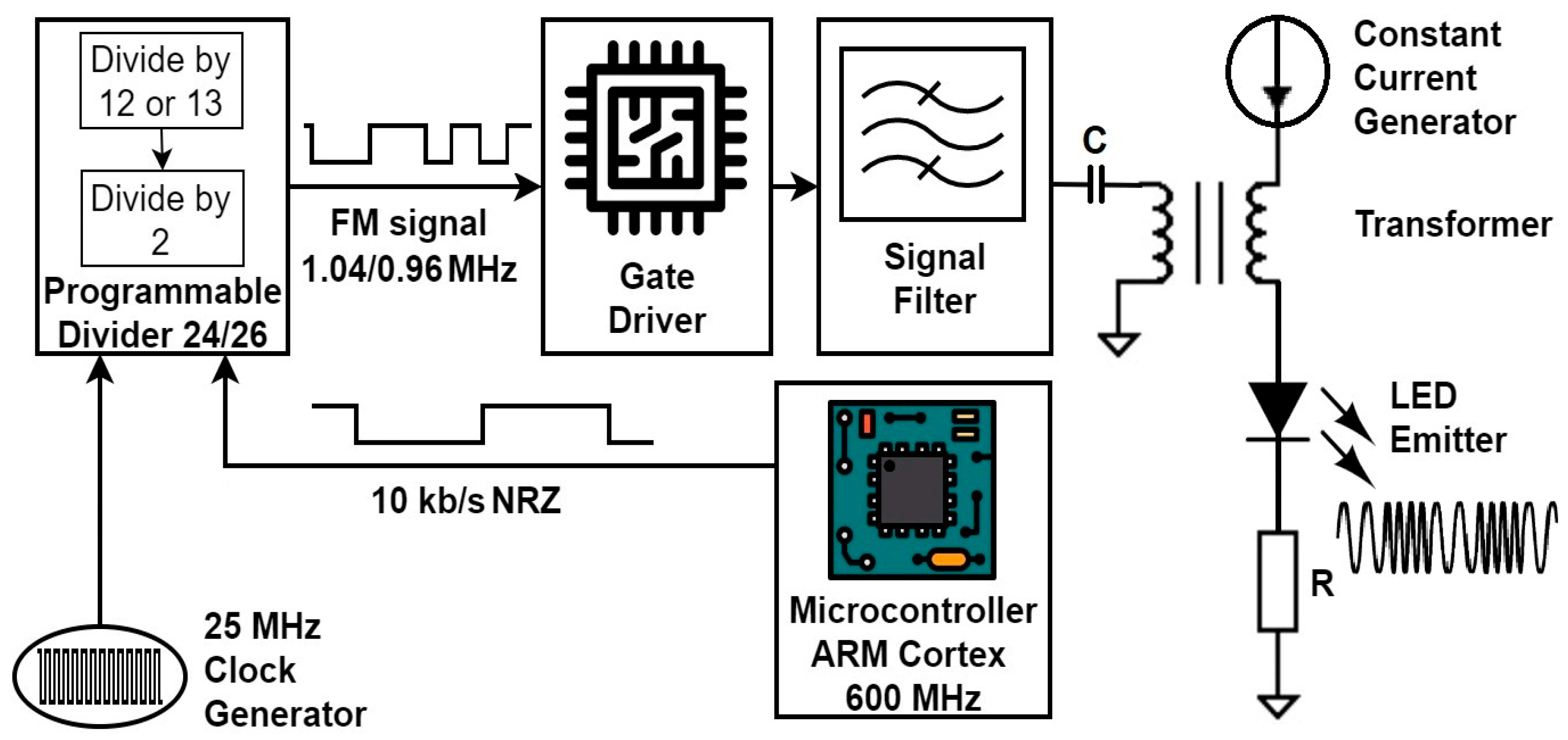
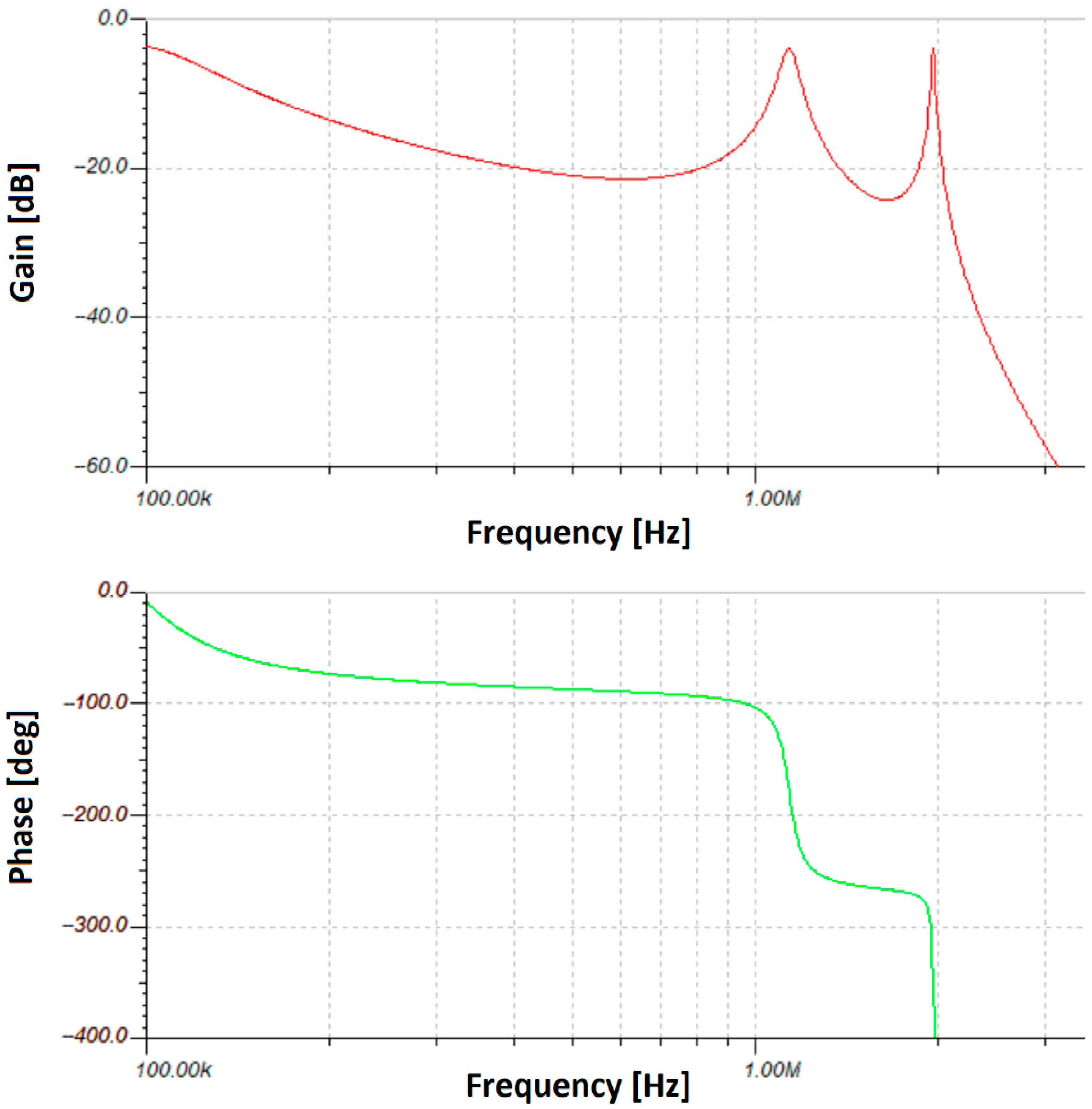
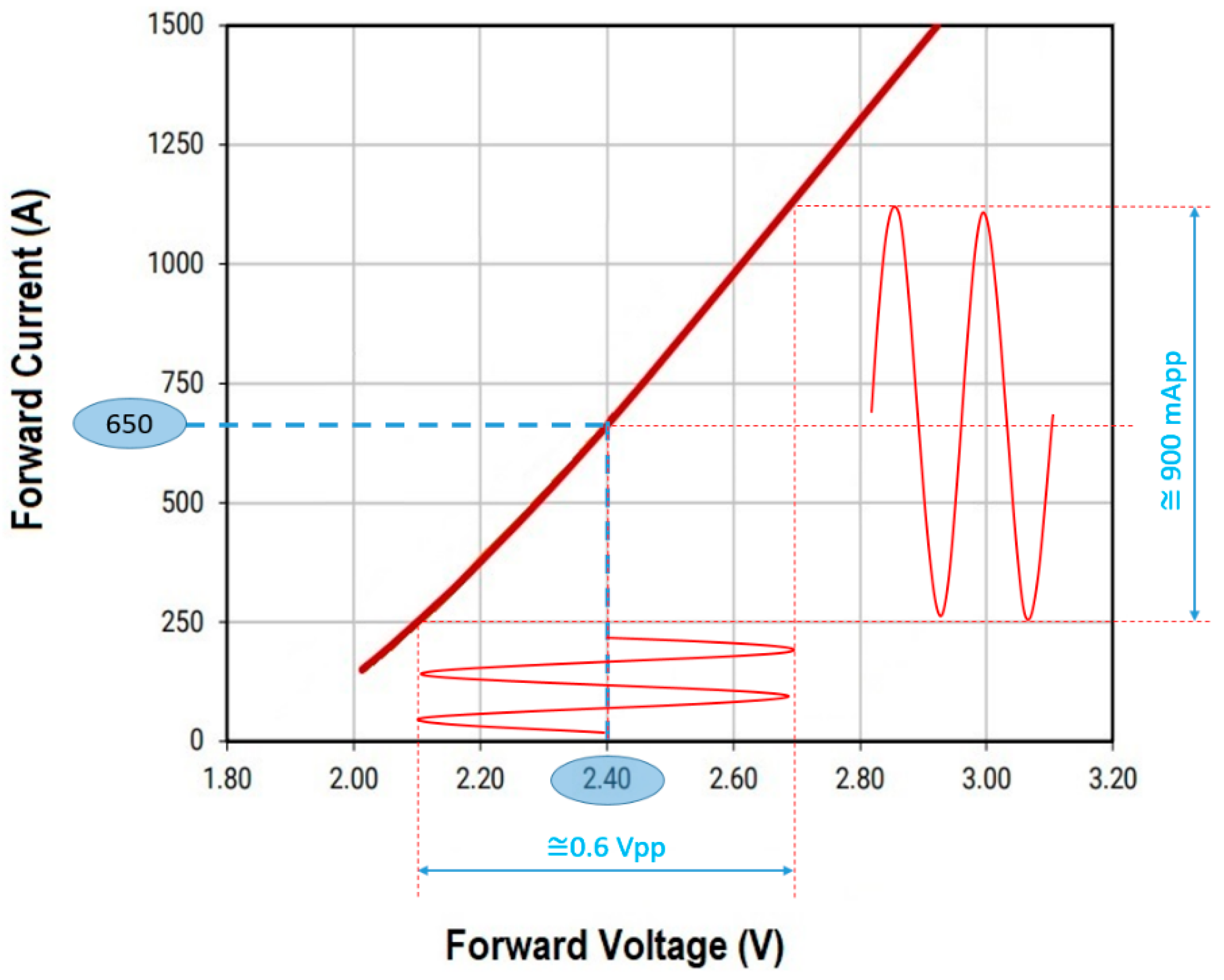
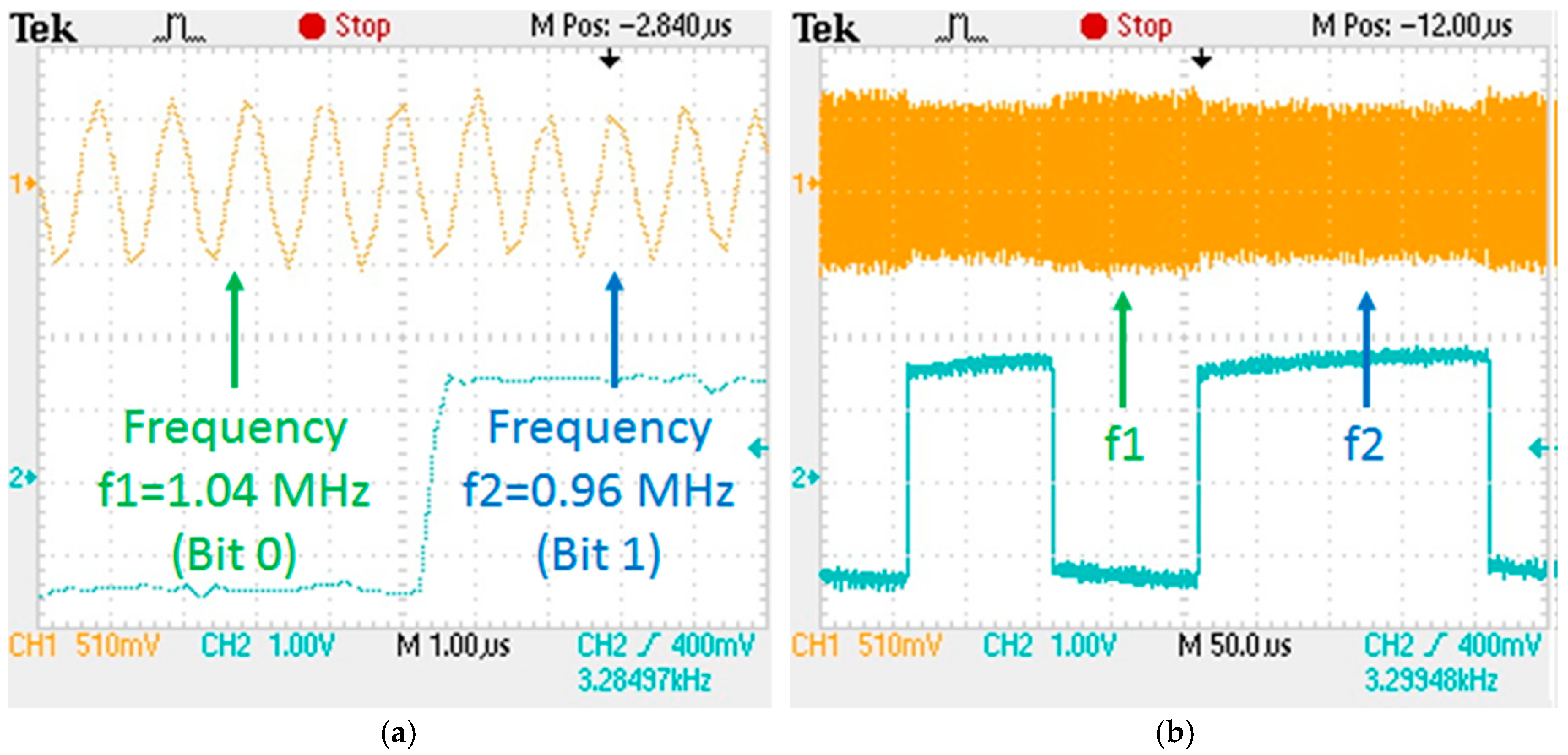

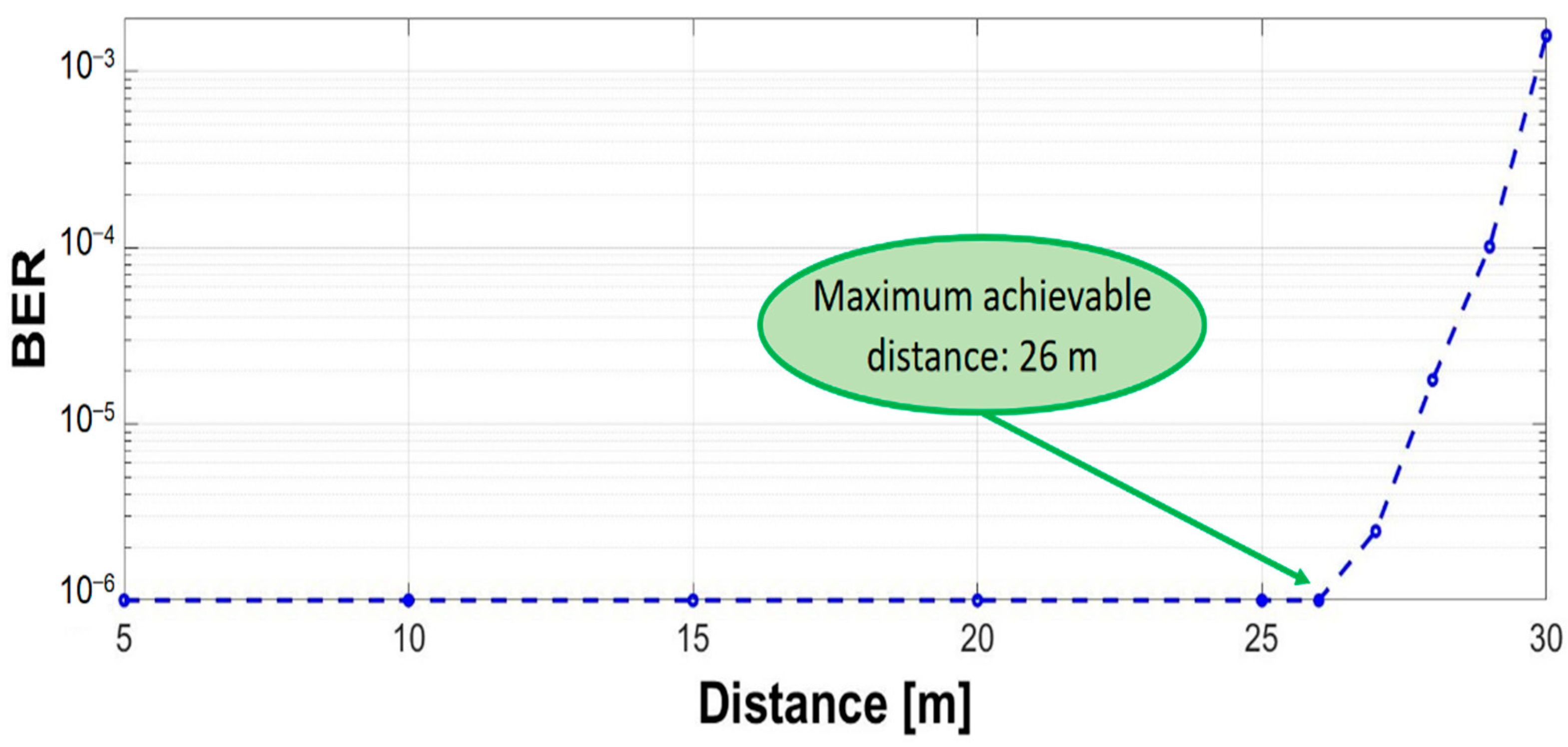
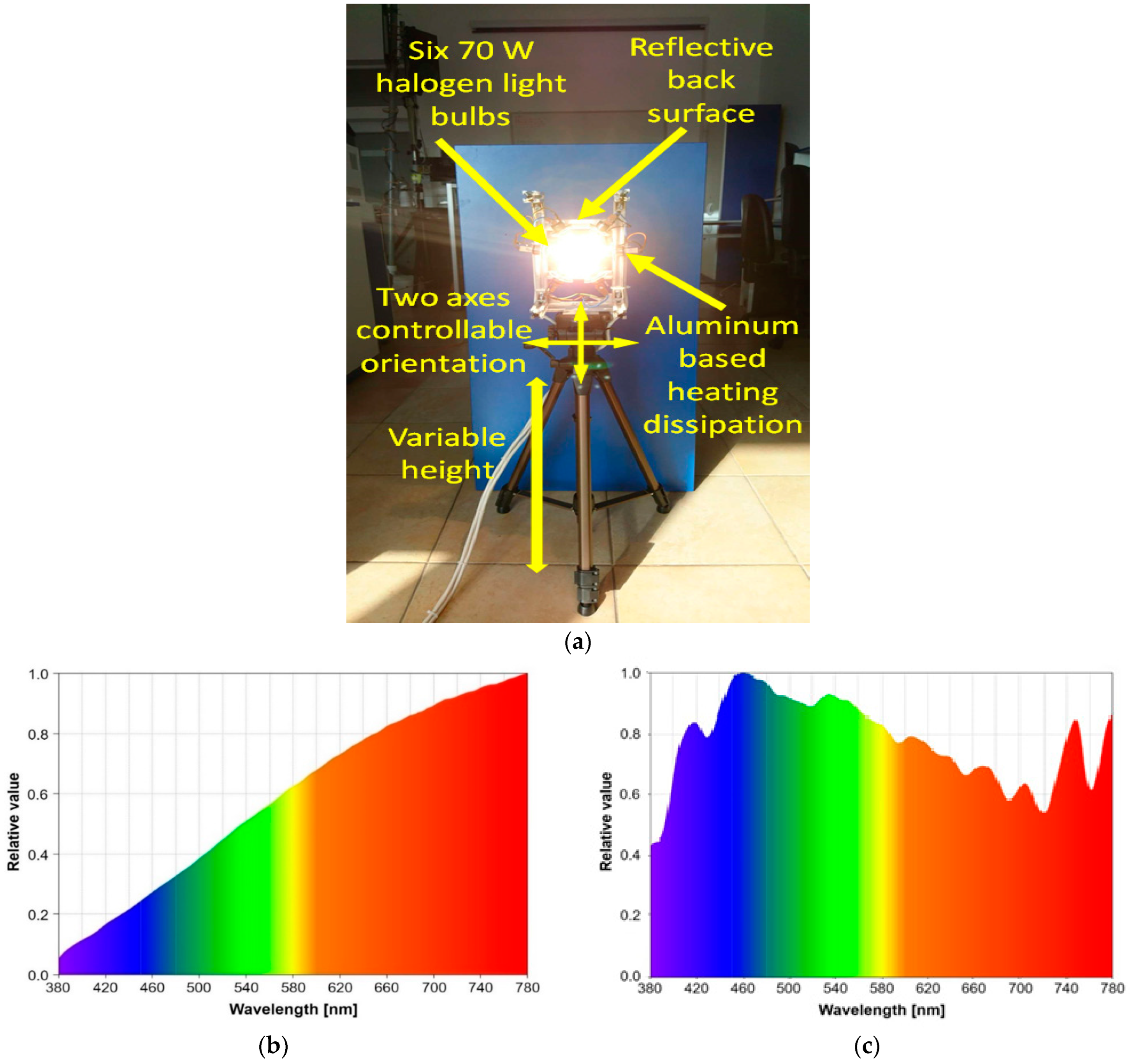

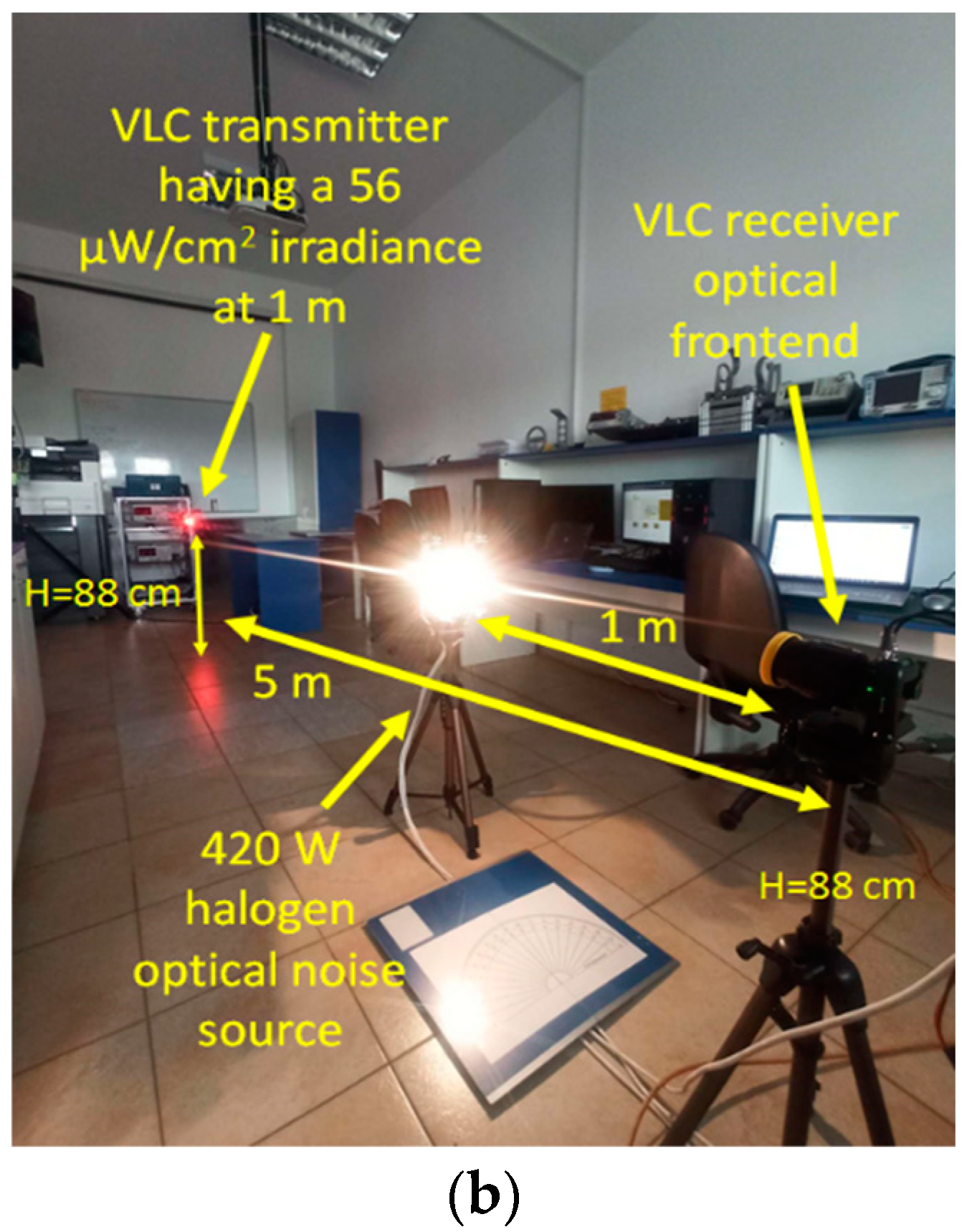
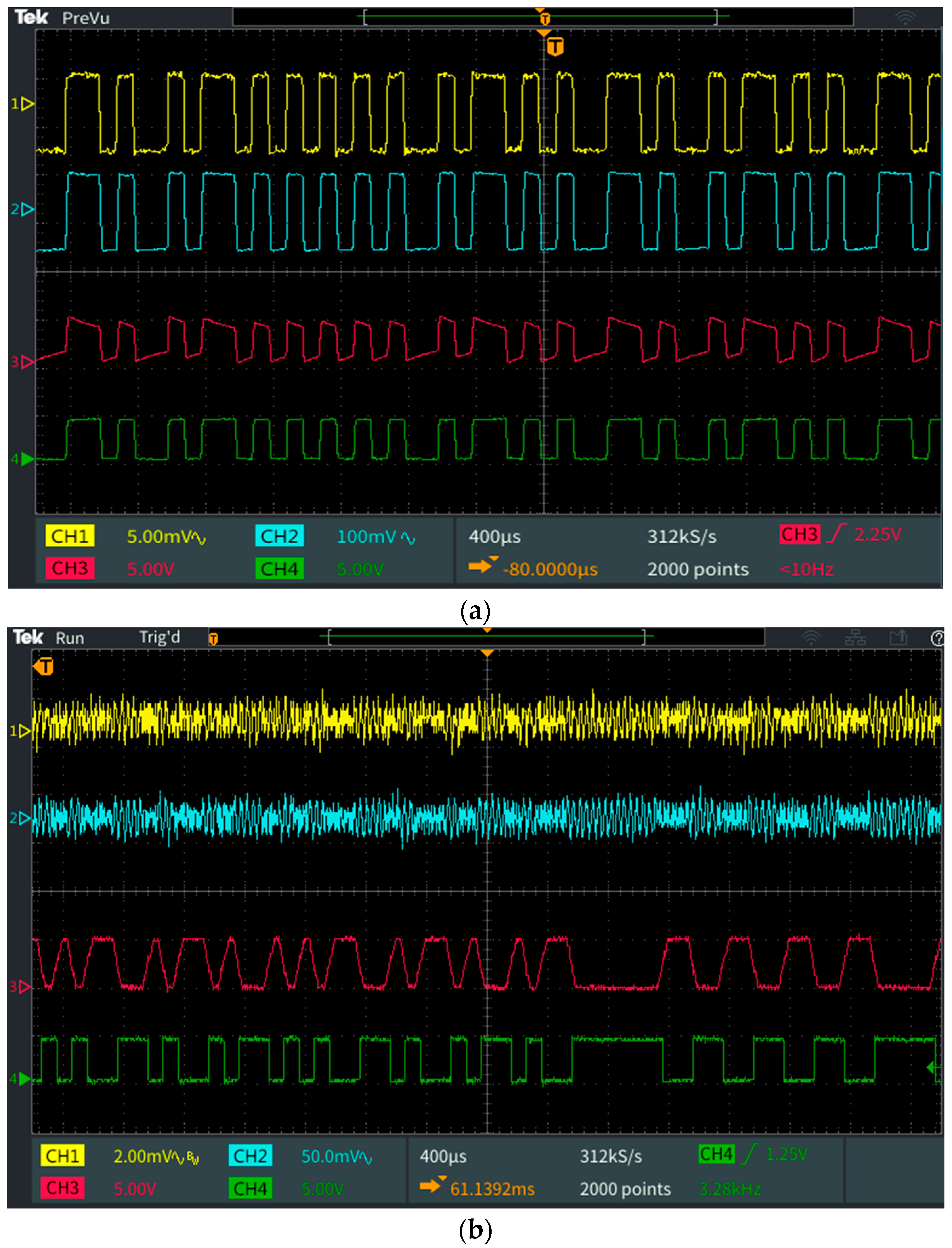

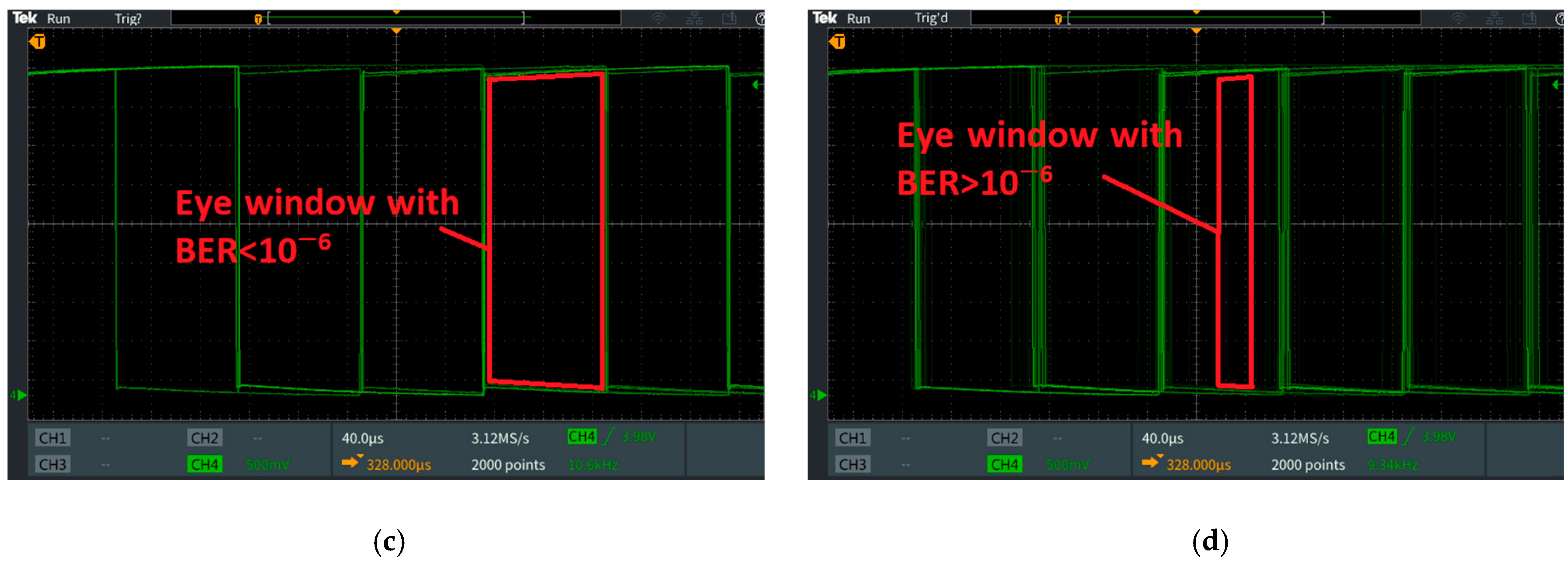
| Parameter | Values |
|---|---|
| Optical source | XP-E2 (CREE red LED) |
| Emitted irradiance at 1 m distance | ≅56 μW/cm2 |
| VLC emitter’s central wavelength | 630 nm |
| Coding technique | NRZ |
| Data rate | 10 kb/s |
| Encoding hardware | Microcontroller 600 MHz ARM Cortex M7 processor |
| Oscillator frequency [MHz] | 25 |
| Total division factor | 24/26 |
| Resulted frequency [MHz] | 1.04/0.96 |
| The ratio of the transformer | 20:4 |
| Filter inductances [μH] | 9 |
| Ferrite rings | T50-1, T50-2 |
| Filter capacitances [pF] | 2 × 270, 2 × 2200 |
| VLC Receiver Blocks | Parameter | Values/Features |
|---|---|---|
| Front-end | Optical filter dominant wavelength | 645 ± 40 nm |
| VLC optical photodetector | PDA100A2 switchable gain transimpedance amplifier | |
| Optical collector’s FoV | ±20° | |
| BFSK demodulator | Sensitivity | 10 mV at a 10−6 BER value |
| Regeneration stage | Square signal regeneration | Schmitt trigger circuit |
| Data processing | Hardware | Microcontroller board with an ARM Cortex M7 processor at 600 MHz |
| Data processing | Rising and falling edge detection and pulse width measurement | |
| Data decoding | Real-time extraction, with data rate of 10 kb/s | |
| Monitored parameters | Real-time BER without forward error correcting codes |
| Parameter | Feature/Values |
|---|---|
| Testing conditions | Low SNR laboratory conditions |
| Emitter–Receiver distance | 5 m |
| Natural ambient light | 10–29 μW/cm2 |
| Modulation technique | Phase 1: BFSK |
| Phase 2: OOK | |
| Coding technique | Phase 1: NRZ Phase 2: Manchester |
| Optical filter | 645 ± 40 nm for direct exposure |
| None for indirect exposure | |
| Data rate | 10 kb/s |
| Noise source | 420 W incandescent light bulbs with a measured irradiance of maximum ≈28,000 µW/cm2 |
| Placement of noise source | At 1 m and an incidence angle of 5° for direct exposure |
| At 1 m and an incidence angle of 30° for indirect exposure | |
| Measured parameter | Real-time BER determination without the use of FEC protocols, with a 10−6 limit |
| Equipment Type | Model |
|---|---|
| Irradiance meter | Delta Ohm HD 2302.0 with LP 471 RAD Probe |
| Optical spectrometer analyzer | Sekonic C-800 |
| Oscilloscope | Tektronix TBS 2104 |
| Parameter | BPSK VLC Prototype | OOK VLC Prototype |
|---|---|---|
| Communication range for BER < 10−6 | 26 m | 26 m |
| BER > 10−6 limit for direct light exposure at 5 m | ≈3500 µW/cm2 | ≈2800 µW/cm2 |
| BER > 10−6 limit for indirect light exposure at 5 m | ≈8100 µW/cm2 ≈65,000 µW/cm2 | ≈6800 µW/cm2 ≈54,000 µW/cm2 |
| Ref. | Modulation/ Coding | Noise Resilience Enhancement Mechanism | BER | Testing conditions | Merits | Disadvantages |
|---|---|---|---|---|---|---|
| [31] | DSSS/SIK | Rather high, provided by DSSS modulation | 10−6–10−4 | Bright daytime conditions exposure | High overall performance (range, noise resilience) | The pseudo noise sequence affects data rate |
| [18,19] | OOK/Manchester | Narrow FOV, optical filters, logarithmic transimpedance circuit | 10−3–10−6 | Up to 65,000 µW/cm2 sunlight exposure (outside the FoV) | Extended dynamic range and enhanced noise resilience | Amplification is reduced as optical noise increases, limiting the communication range |
| [21] | OOK/Manchester | Optical lens | 3 × 10−7 | Indoor with artificial light | Standard compliant systems | Insufficient noise resilience |
| [20] | OOK/Manchester | Optical filtering and SDR processing | 3.1 × 10−7 | 12,000 lux daylight exposure | Improved signal processing; 1 Mb/s data rate | |
| [27] | OFDM | Optical filtering and OFDM | ≈10−3 | 50,350 lux exposure | 1 Gb/s data rate | Low communication range (14 cm) |
| This work | BFSK/NRZ | Optical filtering and BFSK | <10−6 | Up to 65,000 µW/cm2 exposure | Higher noise resilience | Low data rate (10 kb/s) |
Disclaimer/Publisher’s Note: The statements, opinions and data contained in all publications are solely those of the individual author(s) and contributor(s) and not of MDPI and/or the editor(s). MDPI and/or the editor(s) disclaim responsibility for any injury to people or property resulting from any ideas, methods, instructions or products referred to in the content. |
© 2023 by the authors. Licensee MDPI, Basel, Switzerland. This article is an open access article distributed under the terms and conditions of the Creative Commons Attribution (CC BY) license (https://creativecommons.org/licenses/by/4.0/).
Share and Cite
Beguni, C.; Done, A.; Căilean, A.-M.; Avătămăniței, S.-A.; Zadobrischi, E. Experimental Demonstration of a Visible Light Communications System Based on Binary Frequency-Shift Keying Modulation: A New Step toward Improved Noise Resilience. Sensors 2023, 23, 5001. https://doi.org/10.3390/s23115001
Beguni C, Done A, Căilean A-M, Avătămăniței S-A, Zadobrischi E. Experimental Demonstration of a Visible Light Communications System Based on Binary Frequency-Shift Keying Modulation: A New Step toward Improved Noise Resilience. Sensors. 2023; 23(11):5001. https://doi.org/10.3390/s23115001
Chicago/Turabian StyleBeguni, Cătălin, Adrian Done, Alin-Mihai Căilean, Sebastian-Andrei Avătămăniței, and Eduard Zadobrischi. 2023. "Experimental Demonstration of a Visible Light Communications System Based on Binary Frequency-Shift Keying Modulation: A New Step toward Improved Noise Resilience" Sensors 23, no. 11: 5001. https://doi.org/10.3390/s23115001
APA StyleBeguni, C., Done, A., Căilean, A.-M., Avătămăniței, S.-A., & Zadobrischi, E. (2023). Experimental Demonstration of a Visible Light Communications System Based on Binary Frequency-Shift Keying Modulation: A New Step toward Improved Noise Resilience. Sensors, 23(11), 5001. https://doi.org/10.3390/s23115001







